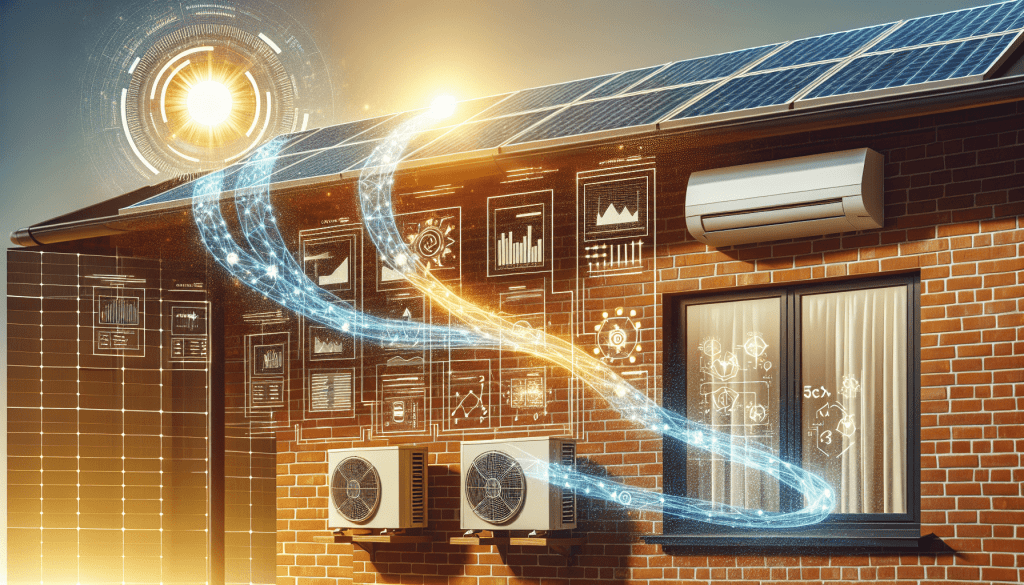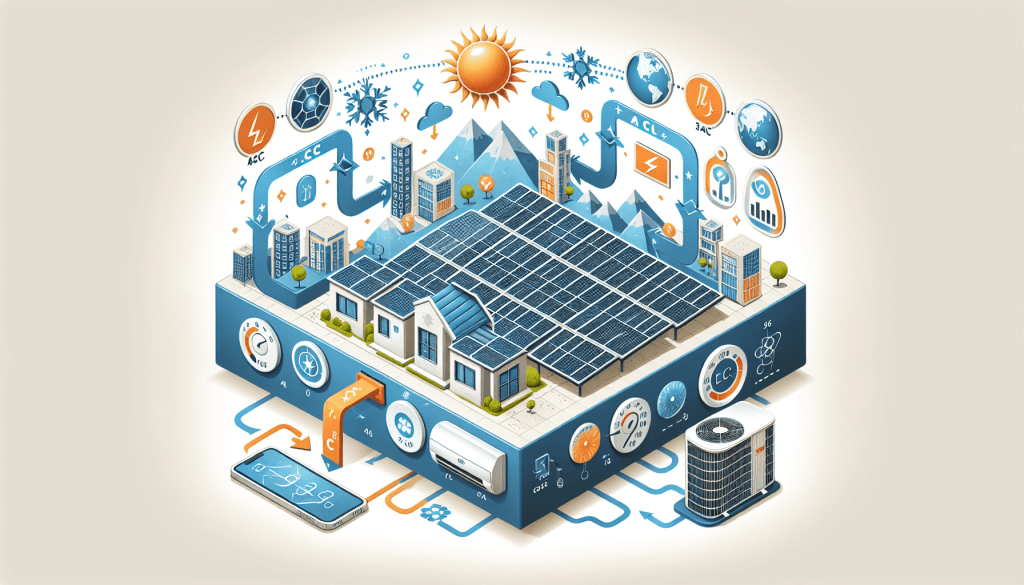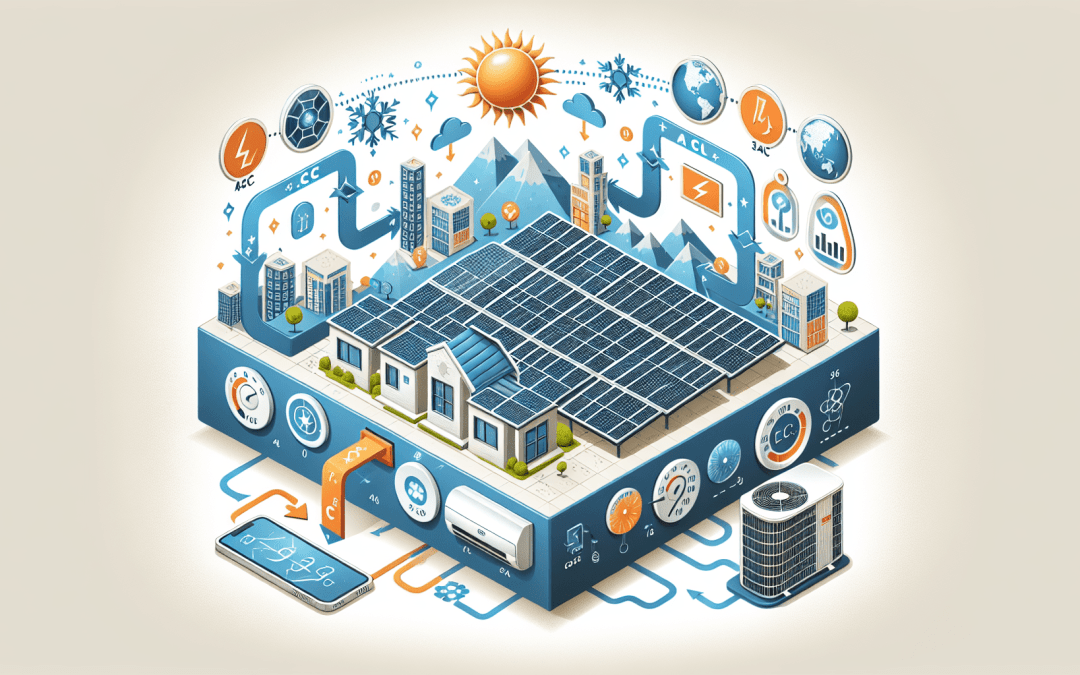How Many Solar Panels To Run Air Conditioner
In this article, we’ll explore how many solar panels you will need to effectively run your air conditioner. With a minimum of 120 volts required to power your AC unit directly from the panels, it’s recommended to have at least 3 solar panels averaging 400 watts and 50 volts each. However, it’s important to factor in the need for a battery backup system if you plan on using the air conditioner at night or during cloudy conditions.
So, let’s dive into the world of solar energy and discover how many panels you’ll need to keep your home cool all summer long.
Solar panel requirements for air conditioner
When considering running an air conditioner with solar panels, there are several requirements to take into account to ensure its efficient and reliable operation. The key requirements include the minimum voltage requirement, average wattage and voltage of solar panels, and determining the number of solar panels needed.
Minimum voltage requirement
In order to power an air conditioner with solar panels, a minimum voltage of 120 volts is necessary. This means that the solar panels should be capable of generating at least this voltage to operate the air conditioner effectively. It is important to check the specifications of the air conditioner to determine its specific voltage requirement.
Average wattage and voltage of solar panels
To calculate the number of solar panels needed, you need to know their average wattage and voltage. In general, solar panels have an average wattage of around 400 watts and a voltage of about 50 volts. These values can vary depending on the specific panels you choose, so it is essential to refer to the manufacturer’s specifications for accurate information.
Number of solar panels needed
To determine the number of solar panels needed to run the air conditioner, you can use the formula: (Number of solar panels) = (Air conditioner wattage) / (Average solar panel wattage)
For example, if your air conditioner has a wattage of 2000 watts and the average solar panel wattage is 400 watts, you would need 5 solar panels to power the air conditioner.
Considerations for running at night or in cloudy conditions
Running an air conditioner solely on solar panels during the night or in cloudy conditions requires additional considerations. It is crucial to have a battery backup system in place to store solar energy for use during these times. This ensures that you have a continuous power supply even when the solar panels are not generating sufficient electricity.
Battery backup system
A battery backup system consists of rechargeable batteries that store the excess solar energy generated during the day and provide power when the solar panels are not producing electricity. These batteries can be connected to the air conditioner to supply power during the night or during periods of low sunlight. It is important to choose batteries with appropriate storage capacity to meet the energy requirements of the air conditioner.
Storage capacity requirements
The storage capacity of the battery backup system is determined by the energy consumption of the air conditioner and the duration for which it needs to run without solar power. To calculate the storage capacity required, you can use the formula: (Battery storage capacity) = (Air conditioner wattage) x (Number of hours required without solar power)
This calculation will give you the amount of energy the batteries should be able to store to ensure uninterrupted operation of the air conditioner.
Optimal battery type
When selecting batteries for the backup system, it is essential to consider the battery type. Deep cycle batteries are commonly used for solar applications due to their ability to withstand frequent discharging and recharging. AGM (Absorbent Glass Mat) batteries are another option, known for their maintenance-free operation and durability. Choosing the right battery type depends on factors such as budget, maintenance requirements, and intended use.

Factors affecting solar panel requirements
Several factors can affect the solar panel requirements for running an air conditioner. These factors include the size and power consumption of the air conditioner, geographic location and climate, and the efficiency of solar panels.
Size and power consumption of air conditioner
The size and power consumption of the air conditioner play a crucial role in determining the number and capacity of solar panels required. Larger air conditioners with higher power consumption will require more solar panels to meet their energy needs. It is important to refer to the air conditioner’s specifications to determine its wattage and adjust the solar panel requirements accordingly.
Geographic location and climate
The geographic location and climate also impact the solar panel requirements. Areas with more sunlight will require fewer solar panels compared to regions with low sunlight. Similarly, areas with extreme climate conditions may require additional solar panels to compensate for increased energy consumption due to higher cooling demands. It is essential to consider these factors to accurately calculate the solar panel requirements for your specific location.
Efficiency of solar panels
The efficiency of solar panels refers to their ability to convert sunlight into electricity. Higher efficiency panels generate more power for the same surface area. When selecting solar panels, it is beneficial to choose panels with high efficiency to maximize energy generation. Higher efficiency panels can reduce the number of panels needed to meet the air conditioner’s energy requirements.
Calculating the wattage requirement
Calculating the wattage requirement involves determining the power consumption of the air conditioner and accounting for additional power requirements during start-up and system losses.
Determining the air conditioner’s wattage
The wattage of the air conditioner can be found in its specifications or on the product label. This value represents the amount of power the air conditioner consumes when it is running. It is essential to use this wattage value for accurate calculations.
Accounting for start-up power
When an air conditioner starts, it requires a higher power surge to initiate the system. This start-up power, also known as inrush current, is typically higher than the air conditioner’s normal running wattage. To account for this, it is recommended to add a buffer in the calculations by multiplying the air conditioner’s wattage by a factor of 1.2 or 1.5.
Factor in system losses
System losses refer to the energy lost during the conversion, storage, and transmission of electricity. It is important to account for these losses to ensure the solar panel and battery system can adequately supply the air conditioner’s power requirements. System losses can vary depending on the efficiency of the components used in the system, so it is advisable to consult with a professional or refer to manufacturer specifications for accurate estimations.

Determining the solar panel capacity
Determining the solar panel capacity involves calculating the total wattage requirement, considering panel efficiency, and accounting for system losses.
Calculating the total wattage requirement
The total wattage requirement is the sum of the air conditioner’s wattage, the additional power for start-up, and the estimated system losses. This calculation ensures that the solar panels can generate enough electricity to meet the air conditioner’s power needs.
To calculate the total wattage requirement, you can use the formula: (Total wattage requirement) = (Air conditioner wattage) x (Buffer factor) + (System losses)
Considering panel efficiency
The efficiency of solar panels affects the amount of electricity they can generate. Higher efficiency panels are more effective at converting sunlight into electricity, resulting in higher power output. When selecting solar panels, it is advisable to choose panels with higher efficiency to maximize energy generation and reduce the number of panels needed.
Accounting for system losses
System losses can occur during the conversion of solar energy into electricity, as well as during electricity transmission and storage. These losses can range from 10% to 30%, depending on the components used in the system. To ensure the solar panels can generate enough electricity, it is crucial to account for these losses in the calculations. Consult with a professional or refer to manufacturer specifications to determine the appropriate loss percentage for your specific system.
Choosing the right solar panels
Choosing the right solar panels involves considering factors such as monocrystalline vs polycrystalline panels, efficiency and power output, durability and warranty.
Monocrystalline vs Polycrystalline panels
Monocrystalline and polycrystalline panels are the two main types of solar panels available. Monocrystalline panels are made from a single crystal structure, offering higher efficiency and sleeker aesthetics. Polycrystalline panels are made from multiple crystals, resulting in slightly lower efficiency but lower production costs. When deciding between the two, consider factors such as budget, available space, and desired efficiency.
Efficiency and power output
Efficiency and power output are important considerations when choosing solar panels. Higher efficiency panels generate more electricity for the same amount of sunlight, resulting in greater energy production. It is essential to compare the efficiency and power output of different panels to ensure they meet the air conditioner’s power requirements.
Durability and warranty
Durability and warranty are crucial factors to consider when selecting solar panels. Solar panels are exposed to various weather conditions, so it is important to choose panels that are built to withstand these elements. Additionally, manufacturers often provide warranties that protect against manufacturing defects and performance issues. Consider the warranty period and the reputation of the manufacturer when making your decision.
Installation considerations
Installing solar panels for powering an air conditioner involves considering factors such as roof orientation and tilt, shade and obstructions, and wiring and electrical connections.
Roof orientation and tilt
The orientation and tilt of the roof can impact the amount of sunlight the solar panels receive. Ideally, the roof should be oriented towards the south in the northern hemisphere or towards the north in the southern hemisphere to maximize sunlight exposure. Additionally, the tilt angle should be adjusted based on the geographic location to optimize solar energy generation.
Shade and obstructions
Shade and obstructions, such as nearby trees or buildings, can significantly impact the performance of solar panels. It is important to choose a location on the roof that is free from shade during peak sunlight hours. Conduct a shade analysis to identify any potential obstructions and ensure that the solar panels will receive uninterrupted sunlight.
Wiring and electrical connections
Proper wiring and electrical connections are essential for the safe and effective operation of the solar panel system. Ensure that the wiring is correctly sized and installed to handle the electrical load. Consult with a professional electrician or solar installer to ensure compliance with local electrical codes and regulations.
Sizing the battery backup system
Sizing the battery backup system involves determining the energy storage needs, choosing between deep cycle vs AGM batteries, and selecting the appropriate battery bank size.
Determining the energy storage needs
To determine the energy storage needs of the battery backup system, consider the duration for which the air conditioner needs to run without solar power. Multiply the air conditioner’s wattage by the number of hours required without solar power to calculate the total energy storage requirement. It is important to ensure that the battery bank can store enough energy to meet the air conditioner’s power needs during this period.
Deep cycle vs AGM batteries
Deep cycle batteries and AGM batteries are commonly used for solar applications. Deep cycle batteries are designed to provide a steady amount of power over an extended period and can handle frequent discharging and recharging. AGM batteries, on the other hand, are maintenance-free and offer higher discharge rates. Consider factors such as maintenance requirements, cost, and expected battery lifespan when choosing between deep cycle and AGM batteries.
Sizing the battery bank
The battery bank size refers to the total capacity of the batteries used in the backup system. It is important to choose an adequate battery bank size to ensure sufficient energy storage. Calculate the total energy storage requirement and select batteries with suitable capacity to meet this requirement. Keep in mind that it is generally recommended to size the battery bank to provide at least 1-3 days of autonomy, depending on your specific needs.
Cost considerations
When considering powering an air conditioner with solar panels, it is important to take into account the costs involved. These costs include solar panel costs, installation costs, and battery backup system costs.
Solar panel costs
The cost of solar panels can vary depending on factors such as the brand, efficiency, and power output. Higher quality and higher efficiency panels generally come at a higher cost. Consider your budget and the specific requirements of your air conditioner when selecting solar panels to ensure a balance between cost and performance.
Installation costs
The installation costs of a solar panel system can include expenses such as mounting equipment, wiring, and labor. The complexity of the installation, roof accessibility, and regional labor costs can all impact the overall installation costs. Consult with multiple solar installers to obtain quotes and compare the costs before making a decision.
Battery backup system costs
The costs associated with a battery backup system include the batteries themselves, charge controllers, inverters, and any additional equipment required for proper functioning. Deep cycle batteries are generally more expensive than AGM batteries, but costs can vary depending on the specific brand and model. Consider the costs of the battery backup system when planning your solar panel installation to ensure that it fits within your budget.
Benefits of powering air conditioner with solar panels
Powering an air conditioner with solar panels offers several benefits beyond just providing cooling comfort. These benefits include energy cost savings, environmental impact, and independence from the grid.
Energy cost savings
One of the primary benefits of utilizing solar panels to power an air conditioner is the potential for significant energy cost savings. By generating your own electricity from the sun, you can reduce or eliminate your reliance on the traditional power grid. This can result in substantial savings on your monthly energy bills, especially during hot summer months when air conditioning usage is high.
Environmental impact
Using solar panels to power an air conditioner is a sustainable and environmentally-friendly solution. Solar energy is a clean and renewable energy source that produces virtually no greenhouse gas emissions. By transitioning to solar power, you can reduce your carbon footprint and contribute to the preservation of the environment for future generations.
Independence from the grid
Powering an air conditioner with solar panels provides a level of independence from the traditional power grid. With a properly designed and functioning solar panel system, you can have peace of mind knowing that you have a reliable source of electricity, even during power outages or grid failures. This independence can be particularly valuable in areas with unreliable or expensive electricity supply.
In conclusion, running an air conditioner with solar panels requires careful consideration of various factors to ensure optimal performance and efficiency. Determining the minimum voltage requirement, calculating the wattage and solar panel capacity, choosing the right solar panels and batteries, and considering installation and cost factors are all crucial steps in successfully powering an air conditioner with solar energy. By harnessing the power of the sun, you can not only enjoy the comfort of cool air but also contribute to a greener and more sustainable future.




